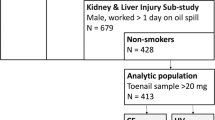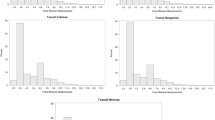Abstract
Since data on mercury (Hg) levels in Caucasians and African Americans (AAs) of both genders are lacking, this study aims to present toenail Hg distributions and explore the potential determinants using data from the Coronary Artery Risk Development in Young Adults Trace Element Study. Data from 4,344 Americans, aged 20–32 in 1987, recruited from Oakland, Chicago, Minneapolis, and Birmingham were used to measure toenail Hg levels by instrumental neutron-activation method. The Hg distribution was described with selected percentiles and geometric means. Multivariable linear regression (MLR) was used to examine potential determinants of Hg levels within ethnicity–gender subgroups. The geometric mean of toenail Hg was 0.212 (95 % CI = 0.207–0.218) μg/g. Hg levels varied geographically with Oakland the highest [0.381 (0.367–0.395) μg/g] and Minneapolis the lowest [0.140 (0.134–0.147) μg/g]. MLR analyses showed that male gender and AA ethnicity were negatively associated with toenail Hg levels, and that age, living in Oakland city, education level, alcohol consumption, and total fish intake were positively associated with toenail Hg concentrations within each ethnicity–gender subgroup. Current smokers were found to have higher Hg only in AA men. This study suggested age, gender, ethnicity, study center, alcohol, education level, and fish consumption consistently predict toenail Hg levels. As fish consumption was the key determinant, avoiding certain types of fish that have relatively high Hg levels may be crucial in reducing Hg intake.

Similar content being viewed by others
References
Alfthan G (1997) Toenail mercury concentration as a biomarker of methylmercury exposure. Biomarker 2(4):233–238
Bakir F, Damluji SF, Amin-Zaki L, Murtadha M, Khalidi A, al-Rawi NY, Tikriti S, Dahahir HI, Clarkson TW, Smith JC, Doherty RA (1973) Methylmercury poisoning in Iraq. Science 181(96):230–241
Becker K, Kaus S, Krause C, Lepom P, Schulz C, Seiwert M, Seifert B (2002) German Environmental Survey 1998 (GerES III): environmental pollutants in blood of the German population. Int J Hyg Environ Health 205(4):297–308
Becker K, Schulz C, Kaus S, Seiwert M, Seifert B (2003) German Environmental Survey 1998 (GerES III): environmental pollutants in the urine of the German population. Int J Hyg Environ Health 206(1):15–24
Bjorkman L, Lundekvam BF, Laegreid T, Bertelsen BI, Morild I, Lilleng P, Lind B, Palm B, Vahter M (2007) Mercury in human brain, blood, muscle and toenails in relation to exposure: an autopsy study. Environ Health 6:30
Bloom NS, Watras CJ, Hurley JP (1991) Impact of acidification on the methylmercury cycle of remote seepage lakes. Water Air Soil Pollut 56:477–491
Boening DW (2000) Ecological effects, transport, and fate of mercury: a general review. Chemosphere 40(12):1335–1351
Brumbaugh WG, Krabbenhoft DP, Helsel DR, Wiener JG, Echols KR (2001) A national pilot study of mercury contamination of aquatic ecosystems along multiple gradients bioaccumulation in fish. U.S. Dept. of the Interior, U.S. Geological Survey. Available from the National Technical Information Service, Springfield, VA
Chalmers AT, Argue DM, Gay DA, Brigham ME, Schmitt CJ, Lorenz DL (2011) Mercury trends in fish from rivers and lakes in the United States, 1969–2005. Environ Monit Assess 175(1-4):175–191. doi:10.1007/s10661-010-1504-6
Dumont C, Girard M, Bellavance F, Noel F (1998) Mercury levels in the Cree population of James Bay, Quebec, from 1988 to 1993/94. CMAJ 158(11):1439–1445
Friedman GD, Cutter GR, Donahue RP, Hughes GH, Hulley SB, Jacobs DR Jr, Liu K, Savage PJ (1988) CARDIA: study design, recruitment, and some characteristics of the examined subjects. J Clin Epidemiol 41(11):1105–1116
Fujita M, Takabatake E (1977) Mercury levels in human maternal and neonatal blood, hair and milk. Bull Environ Contam Toxicol 18(2):205–209
Garland M, Morris JS, Rosner BA, Stampfer MJ, Spate VL, Baskett CJ, Willett WC, Hunter DJ (1993) Toenail trace element levels as biomarkers: reproducibility over a 6-year period. Cancer Epidemiol Biomarkers Prev 2(5):493–497
Guallar E, Sanz-Gallardo MI, van’t Veer P, Bode P, Aro A, Gomez-Aracena J, Kark JD, Riemersma RA, Martin-Moreno JM, Kok FJ (2002) Mercury, fish oils, and the risk of myocardial infarction. N Engl J Med 347(22):1747–1754
Hansen JC, Danscher G (1997) Organic mercury: an environmental threat to the health of dietary-exposed societies? Rev Environ Heal 12(2):107–116
Harada M (1995) Minamata disease: methylmercury poisoning in Japan caused by environmental pollution. Crit Rev Toxicol 25(1):1–24
He K (2009) Fish, long-chain omega-3 polyunsaturated fatty acids and prevention of cardiovascular disease—eat fish or take fish oil supplement? Prog Cardiovasc Dis 52(2):95–114
He K (2011) Trace elements in nails as biomarkers in clinical research. Eur J Clin Invest 41(1):98–102
Hightower JM, O'Hare A, Hernandez GT (2006) Blood mercury reporting in NHANES: identifying Asian, Pacific Islander, Native American, and multiracial groups. Environ Health Perspect 114(2):173–175
Hirayama K, Yasutake A (1986) Sex and age differences in mercury distribution and excretion in methylmercury-administered mice. J Toxicol Environ Health 18(1):49–60
Houston TK, Person SD, Pletcher MJ, Liu K, Iribarren C, Kiefe CI (2006) Active and passive smoking and development of glucose intolerance among young adults in a prospective cohort: CARDIA study. BMJ 332(7549):1064–1069
Leino T, Lodenius M (1995) Human hair mercury levels in Tucurui area, State of Para, Brazil. Sci Total Environ 175(2):119–125
Mahaffey KR, Clickner RP, Bodurow CC (2004) Blood organic mercury and dietary mercury intake: National Health and Nutrition Examination Survey, 1999 and 2000. Environ Health Perspect 112(5):562–570
McDonald A, Van Horn L, Slattery M, Hilner J, Bragg C, Caan B, Jacobs D Jr, Liu K, Hubert H, Gernhofer N et al (1991) The CARDIA dietary history: development, implementation, and evaluation. J Am Diet Assoc 91(9):1104–1112
Morris JS, Stampfer MJ, Willett WC (1983) Dietary selenium in humans: toenails as an indicator. Biol Trace Elem Res 5:529–537
Mortada WI, Sobh MA, El-Defrawy MM (2004) The exposure to cadmium, lead and mercury from smoking and its impact on renal integrity. Med Sci Monit 10(3):CR112–CR116
Mozaffarian D, Shi P, Morris JS, Spiegelman D, Grandjean P, Siscovick DS, Willett WC, Rimm EB (2011) Mercury exposure and risk of cardiovascular disease in two U.S. cohorts. N Engl J Med 364(12):1116–1125
Ohno T, Sakamoto M, Kurosawa T, Dakeishi M, Iwata T, Murata K (2007) Total mercury levels in hair, toenail, and urine among women free from occupational exposure and their relations to renal tubular function. Environ Res 103(2):191–197
Oken E, Radesky JS, Wright RO, Bellinger DC, Amarasiriwardena CJ, Kleinman KP, Hu H, Gillman MW (2008) Maternal fish intake during pregnancy, blood mercury levels, and child cognition at age 3 years in a US cohort. Am J Epidemiol 167(10):1171–1181
Rees JR, Sturup S, Chen C, Folt C, Karagas MR (2007) Toenail mercury and dietary fish consumption. J Expo Sci Environ Epidemiol 17(1):25–30
Schober SE, Sinks TH, Jones RL, Bolger PM, McDowell M, Osterloh J, Garrett ES, Canady RA, Dillon CF, Sun Y, Joseph CB, Mahaffey KR (2003) Blood mercury levels in US children and women of childbearing age, 1999–2000. JAMA 289(13):1667–1674
Shacklette HT, Boerngen JG (1984) Element concentrations in soils and other surficial materials of the conterminous United States. U.S. Dept. of the Interior. For sale by the Distribution Branch, U.S. Geological Survey, Alexandria, VA
Smith JC, Allen PV, Von Burg R (1997) Hair methylmercury levels in U.S. women. Arch Environ Health 52(6):476–480
Son JY, Lee J, Paek D, Lee JT (2009) Blood levels of lead, cadmium, and mercury in the Korean population: results from the Second Korean National Human Exposure and Bio-monitoring Examination. Environ Res 109(6):738–744
StataCorp LP (2009) Getting started with Stata for Windows, release 11. StataCorp LP, College Station, TX
US-EPA (1997) Mercury study report to Congress. Volume IV: an assessment of exposure to mercury in the United States
Weil M, Bressler J, Parsons P, Bolla K, Glass T, Schwartz B (2005) Blood mercury levels and neurobehavioral function. JAMA 293(15):1875–1882
Willett WC (1998) Nutritional epidemiology, 2nd edn. Oxford University Press, New York
Xun P, Liu K, Morris JS, Daviglus ML, Stevens J, Jacobs DR Jr, He K (2010) Associations of toenail selenium levels with inflammatory biomarkers of fibrinogen, high-sensitivity c-reactive protein, and interleukin-6: The CARDIA Trace Element Study. Am J Epidemiol 171(7):793–800
Xun P, Hou N, Daviglus M, Liu K, Morris JS, Shikany JM, Sidney S, Jacobs DR, He K (2011) Fish oil, selenium and mercury in relation to incidence of hypertension: a 20-year follow-up study. J Intern Med 270(2):175–186
Yoshizawa K, Rimm EB, Morris JS, Spate VL, Hsieh CC, Spiegelman D, Stampfer MJ, Willett WC (2002) Mercury and the risk of coronary heart disease in men. N Engl J Med 347(22):1755–1760
Acknowledgments
This study was supported by a grant R01HL081572 and contracts N01-HC-48047, N01-HC-48048, N01-HC-48049, N01-HC-48050, and N01-HC-95095 from the National Institutes of Health. The authors thank Drs. Lyn M. Steffen and Young-il Kim for their helpful comments. The authors also thank the other investigators and staff of the Coronary Artery Risk Development in Young Adults (CARDIA) Study for their valuable contributions.
Author information
Authors and Affiliations
Corresponding author
Additional information
Responsible editor: Vera Slaveykova
Rights and permissions
About this article
Cite this article
Xun, P., Liu, K., Morris, J.S. et al. Distributions and determinants of mercury concentrations in toenails among American young adults: the CARDIA Trace Element Study. Environ Sci Pollut Res 20, 1423–1430 (2013). https://doi.org/10.1007/s11356-012-1126-3
Received:
Accepted:
Published:
Issue Date:
DOI: https://doi.org/10.1007/s11356-012-1126-3




